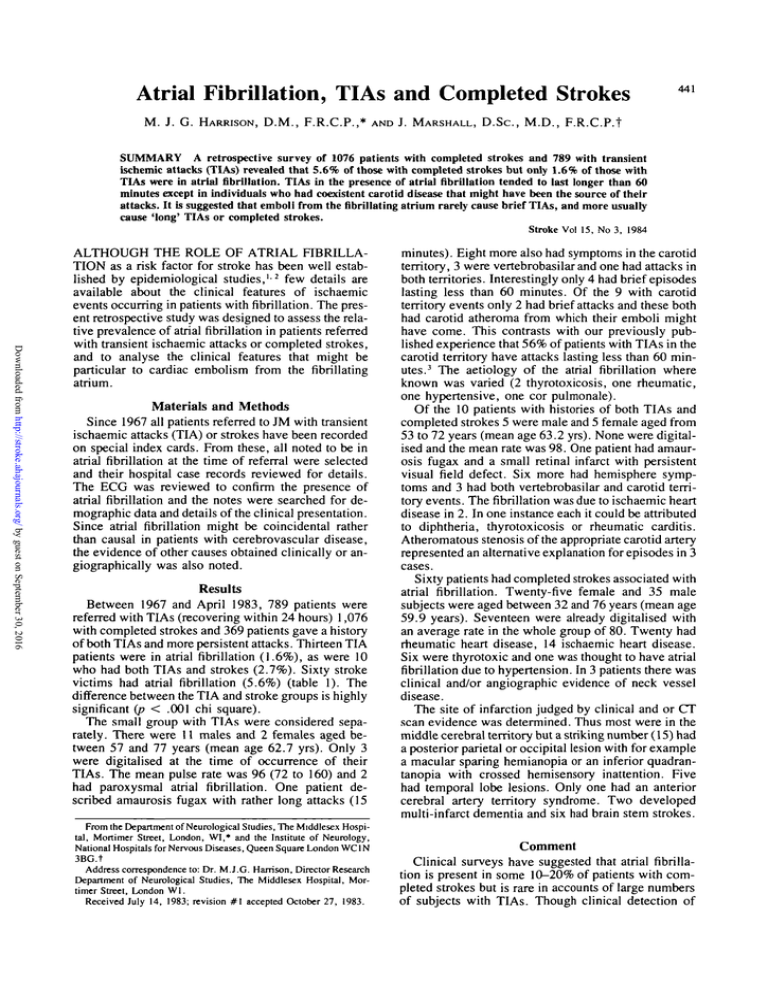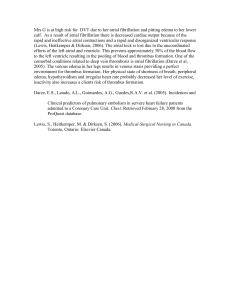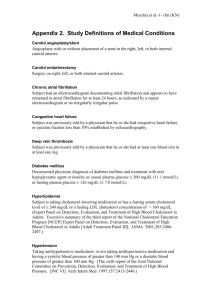
Atrial Fibrillation, TIAs and Completed Strokes
M. J. G.
HARRISON,
D.M., F.R.C.P.,*
AND
J.
MARSHALL, D . S C ,
441
M.D., F.R.C.P.t
SUMMARY A retrospective survey of 1076 patients with completed strokes and 789 with transient
ischemic attacks (TIAs) revealed that 5.6% of those with completed strokes but only 1.6% of those with
TIAs were in atrial fibrillation. TIAs in the presence of atrial fibrillation tended to last longer than 60
minutes except in individuals who had coexistent carotid disease that might have been the source of their
attacks. It is suggested that emboli from the fibrillating atrium rarely cause brief TIAs, and more usually
cause 'long' TIAs or completed strokes.
Stroke Vol 15, No 3, 1984
Downloaded from http://stroke.ahajournals.org/ by guest on September 30, 2016
ALTHOUGH THE ROLE OF ATRIAL FIBRILLATION as a risk factor for stroke has been well established by epidemiological studies,1-2 few details are
available about the clinical features of ischaemic
events occurring in patients with fibrillation. The present retrospective study was designed to assess the relative prevalence of atrial fibrillation in patients referred
with transient ischaemic attacks or completed strokes,
and to analyse the clinical features that might be
particular to cardiac embolism from the fibrillating
atrium.
Materials and Methods
Since 1967 all patients referred to JM with transient
ischaemic attacks (TIA) or strokes have been recorded
on special index cards. From these, all noted to be in
atrial fibrillation at the time of referral were selected
and their hospital case records reviewed for details.
The ECG was reviewed to confirm the presence of
atrial fibrillation and the notes were searched for demographic data and details of the clinical presentation.
Since atrial fibrillation might be coincidental rather
than causal in patients with cerebrovascular disease,
the evidence of other causes obtained clinically or angiographically was also noted.
Results
Between 1967 and April 1983, 789 patients were
referred with TIAs (recovering within 24 hours) 1,076
with completed strokes and 369 patients gave a history
of both TIAs and more persistent attacks. Thirteen TIA
patients were in atrial fibrillation (1.6%), as were 10
who had both TIAs and strokes (2.7%). Sixty stroke
victims had atrial fibrillation (5.6%) (table 1). The
difference between the TIA and stroke groups is highly
significant (p < .001 chi square).
The small group with TIAs were considered separately. There were 11 males and 2 females aged between 57 and 77 years (mean age 62.7 yrs). Only 3
were digitalised at the time of occurrence of their
TIAs. The mean pulse rate was 96 (72 to 160) and 2
had paroxysmal atrial fibrillation. One patient described amaurosis fugax with rather long attacks (15
From the Department of Neurological Studies, The Middlesex Hospital, Mortimer Street, London, WI,* and the Institute of Neurology,
National Hospitals for Nervous Diseases, Queen Square London WC1N
3BG.t
Address correspondence to: Dr. M.J.G. Harrison, Director Research
Department of Neurological Studies, The Middlesex Hospital, Mortimer Street, London Wl.
Received July 14, 1983; revision # 1 accepted October 27, 1983.
minutes). Eight more also had symptoms in the carotid
territory, 3 were vertebrobasilar and one had attacks in
both territories. Interestingly only 4 had brief episodes
lasting less than 60 minutes. Of the 9 with carotid
territory events only 2 had brief attacks and these both
had carotid atheroma from which their emboli might
have come. This contrasts with our previously published experience that 56% of patients with TIAs in the
carotid territory have attacks lasting less than 60 minutes. 3 The aetiology of the atrial fibrillation where
known was varied (2 thyrotoxicosis, one rheumatic,
one hypertensive, one cor pulmonale).
Of the 10 patients with histories of both TIAs and
completed strokes 5 were male and 5 female aged from
53 to 72 years (mean age 63.2 yrs). None were digitalised and the mean rate was 98. One patient had amaurosis fugax and a small retinal infarct with persistent
visual field defect. Six more had hemisphere symptoms and 3 had both vertebrobasilar and carotid territory events. The fibrillation was due to ischaemic heart
disease in 2. In one instance each it could be attributed
to diphtheria, thyrotoxicosis or rheumatic carditis.
Atheromatous stenosis of the appropriate carotid artery
represented an alternative explanation for episodes in 3
cases.
Sixty patients had completed strokes associated with
atrial fibrillation. Twenty-five female and 35 male
subjects were aged between 32 and 76 years (mean age
59.9 years). Seventeen were already digitalised with
an average rate in the whole group of 80. Twenty had
rheumatic heart disease, 14 ischaemic heart disease.
Six were thyrotoxic and one was thought to have atrial
fibrillation due to hypertension. In 3 patients there was
clinical and/or angiographic evidence of neck vessel
disease.
The site of infarction judged by clinical and or CT
scan evidence was determined. Thus most were in the
middle cerebral territory but a striking number (15) had
a posterior parietal or occipital lesion with for example
a macular sparing hemianopia or an inferior quadrantanopia with crossed hemisensory inattention. Five
had temporal lobe lesions. Only one had an anterior
cerebral artery territory syndrome. Two developed
multi-infarct dementia and six had brain stem strokes.
Comment
Clinical surveys have suggested that atrial fibrillation is present in some 10-20% of patients with completed strokes but is rare in accounts of large numbers
of subjects with TIAs. Though clinical detection of
STROKE
442
TABLE 1 Prevalence of Atrial Fibrillation in Patients Referred
with TIAs, Strokes or a History of Both Kinds of Event
n
Atrial
fibrillation
Percentage
1076
60
5.6
TIAs
789
13
1.6
TIAs and strokes
369
10
2.7
Strokes
Downloaded from http://stroke.ahajournals.org/ by guest on September 30, 2016
possible cardiac sources of embolism underestimates
their rate of discovery at autopsy,4 the identification of
atrial fibrillation is simple and it is unlikely that many
cases are missed.
Atrial fibrillation was found in 5.6% of cases of
completed stroke and in 1.6% of patients with TIAs
and 2.7% of those with both TIAs and completed
events. Whilst selection factors clearly play a role it
seems likely that there is a real difference in the prevalence of atrial fibrillation amongst individuals with
TIAs and completed strokes. The cause of the atrial
fibrillation was often unknown. As echocardiography
was not carried out some valvular heart lesions were
probably missed but it nevertheless seems likely that
many were examples of lone fibrillation also found by
Gautier and Morelot3 to be the commonest aetiology in
current practice. As noted by others atrial fibrillation
of any cause can be associated with presumed embolism.2 Nine patients were thyrotoxic, 22 had rheumatic
heart disease, and 16 ischaemic heart disease. One had
diphtheric heart damage, another cor pulmonale. Only
20 of the whole group were digitalised (24%) and the
pulse rate was at least 90 in 46% suggesting that an
uncontrolled rate may be a factor in the genesis of
embolism.
As well as the rarity of atrial fibrillation amongst
TIA patients, it was noteworthy that brief attacks were
less usual than in our survey of TIAs associated with
carotid stenosis.3 When brief attacks in the carotid
territory occurred in patients with atrial fibrillation
there was commonly an alternative possible embolic
VOL 15, No 3, MAY-JUNE
1984
source in the neck vessels. It appears that the size of
emboli emanating from the atrium are more likely to
cause strokes than TIAs, and if they do cause TIAs
these are likely to last hours not minutes.
The present evidence suggests that TIAs should not
be too easily attributed to atrial fibrillation, especially
if brief. Non-invasive investigation of the carotid vessels or digital subtraction angiography would seem
indicated in these cases to detect alternative sources of
embolism. In the case of completed strokes only 3 had
evidence of a possible atheromatous source for their
deficit (i.e. 5% compared with 30% of the TIA patients
and 30% of those with both TIAs and strokes).
The sites of cerebral infarcts in association with
atrial fibrillation were also of interest. The rarity of
embolism into the anterior cerebral artery was confirmed. A striking number had signs of infarction in
the posterior parietal and occipital areas.
The present findings suggest the concept that the
nature of emboli affects their sequelae. Whilst the emboli from carotid stenosis commonly causes TIAs, but
less frequently strokes,6 those from atrial fibrillation
appear to cause longer TIAs, and more usually completed strokes.
References
1. Wolff PA, DawberTR, Thomas ME, Kannel WB. Epidemiologic
assessment of chronic atrial fibrillation and risk of stroke: The
Framingham study. Neurology 28: 973-977, 1978
2 Kannel WB, Abbott RD, Savage DD, McNamara PM: Epidemiologic features of chronic atrial fibrillation: The Framingham
study. New Eng J Med 306: 1018-1022, 1982
3 Harrison MJG, Marshall J, Thomas D: Relevance of duration of
transient ischaemic attacks in carotid territory Brit Med J 1: 15781579, 1978
4. Humphries PRD and Harrison MJG: How often can an embolic
stroke be diagnosed clinically. A clinicopathological correlation.
Submitted for publication
5 Gautier JC, Morelot D: Infarctus cerebraux. Etude de leur prevention. Nouv Presse Med 4: 75-80, 1975
6 Harrison MJG: Thromboembolism, In: Cerebral Vascular Disease,
(eds) Harrison MJG and Dyken M. Butterworths, London, 171195, 1983
Atrial fibrillation, TIAs and completed strokes.
M J Harrison and J Marshall
Stroke. 1984;15:441-442
doi: 10.1161/01.STR.15.3.441
Downloaded from http://stroke.ahajournals.org/ by guest on September 30, 2016
Stroke is published by the American Heart Association, 7272 Greenville Avenue, Dallas, TX 75231
Copyright © 1984 American Heart Association, Inc. All rights reserved.
Print ISSN: 0039-2499. Online ISSN: 1524-4628
The online version of this article, along with updated information and services, is located on the
World Wide Web at:
http://stroke.ahajournals.org/content/15/3/441
Permissions: Requests for permissions to reproduce figures, tables, or portions of articles originally published in
Stroke can be obtained via RightsLink, a service of the Copyright Clearance Center, not the Editorial Office.
Once the online version of the published article for which permission is being requested is located, click Request
Permissions in the middle column of the Web page under Services. Further information about this process is
available in the Permissions and Rights Question and Answer document.
Reprints: Information about reprints can be found online at:
http://www.lww.com/reprints
Subscriptions: Information about subscribing to Stroke is online at:
http://stroke.ahajournals.org//subscriptions/






